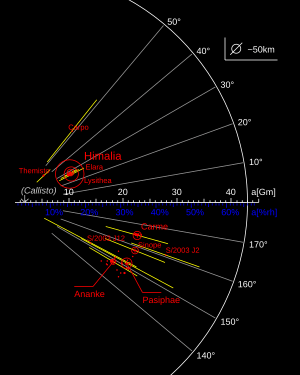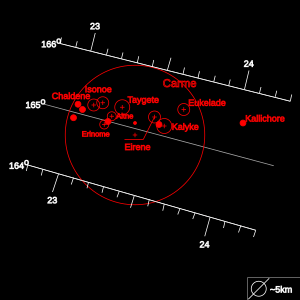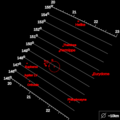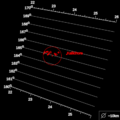Carme group facts for kids
The Carme group is a family of small moons that orbit the giant planet Jupiter. These moons are special because they all travel around Jupiter in a backward direction compared to most other moons. Scientists believe they all came from the same larger object that broke apart a long, long time ago.
These moons orbit Jupiter quite far away, between 22.9 million and 24.1 million kilometers (about 14.2 million to 15 million miles). They also have orbits that are very tilted, between 164.9 and 165.5 degrees, which is why they are called "retrograde" – they go the opposite way of Jupiter's rotation. Their paths around Jupiter are also a bit stretched out, not perfectly round.

Contents
Who are the Moons in the Carme Group?
The main members of this group are:
- Carme (the biggest moon, which the group is named after)
- Taygete
- Eukelade
- S/2003 J 5
- Chaldene
- Isonoe
- Kalyke (this one looks a bit redder than the others)
- Erinome
- Aitne
- Kale
- Pasithee
- S/2003 J 9
- S/2003 J 10
The International Astronomical Union (IAU) is the group that names planets, moons, and other space objects. For all moons that orbit backward (retrograde moons), like those in the Carme group, the IAU makes sure their names end with the letter -e.
How Did the Carme Group Form?
Scientists think that the Carme group moons were once a single, larger space rock. This rock probably broke into many pieces when it was hit by something else a very long time ago. We have a few clues that support this idea:
- All the moons in the group appear to be a light red color.
- When scientists study their light using special tools (infrared spectra), they look similar to a type of space rock called D-type asteroids. This suggests they all came from the same parent body.
See also
 In Spanish: Grupo de Carmé para niños
In Spanish: Grupo de Carmé para niños
Images for kids




